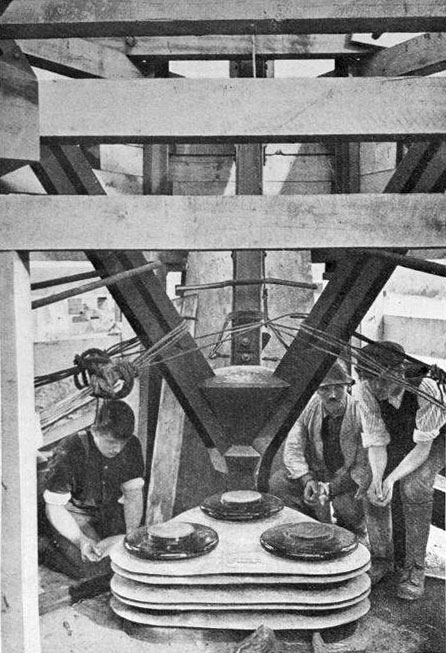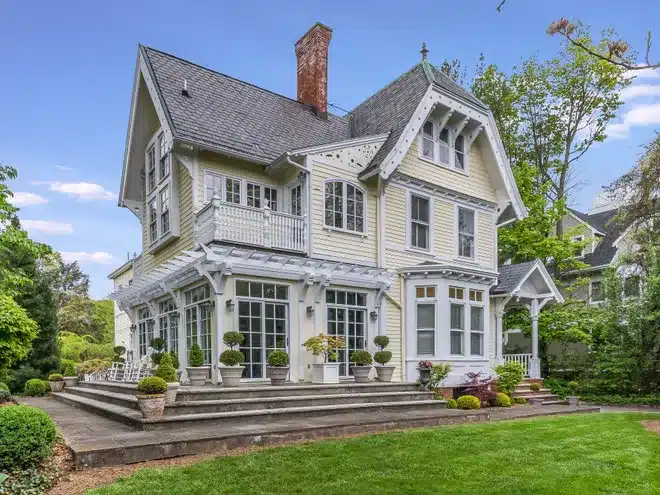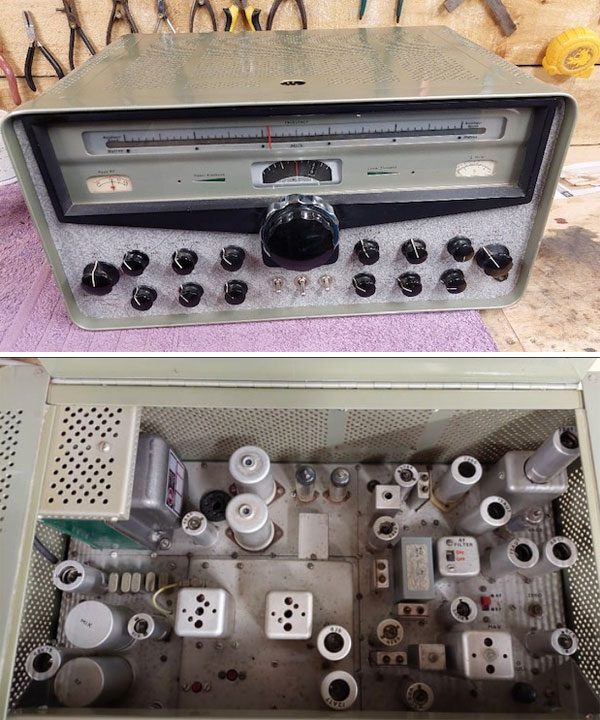This is a free fortnightly newsletter about the New Zealand Net.
If you would like to be notified by email when a new edition is published, please contact ZL1NZ.
Browse our Newsletter Archive and List of Net Tips.
Featured key

Ultimate key. Photo: ZL1PSH
The Ultimate key was made by Radio (1936) Limited, an Auckland company. RJ (Jack) Orbell ZL1AX was the Chief Engineer and a Director of that company, and many of its products, including radio receivers, carried the Ultimate brand name.
The description of the key in the 1942 Lamphouse Annual catalogue is as follows: “Heavy brass arm and bridge. Fine adjustment of spacing and tension provided. Wooden knob and finger rest flange, ensuring comfortable operation grip. Mounted on wooden base, finished in varnish. Measures 6 ins long, 3 ins wide, 3 ins high (overall).” Catalogue number PH111, 16 shillings and 9 pence each.
Source: NZ Morse Key Directory
* If you have an interesting key for this feature, please send a nice clear photo and a few words describing it.
Quick notes
 The Sangster Shield QRP contest again drew lots of interest from NZ Netters. Gerard ZL2GVA won the Arthur Stevens Trophy for top score from the South Island – taking it away from Barry ZL2LN who has won it TEN times! Gerard (pictured here with fans at the awards ceremony) also won 2nd place overall, and Barry took 3rd place among South Island stations.
The Sangster Shield QRP contest again drew lots of interest from NZ Netters. Gerard ZL2GVA won the Arthur Stevens Trophy for top score from the South Island – taking it away from Barry ZL2LN who has won it TEN times! Gerard (pictured here with fans at the awards ceremony) also won 2nd place overall, and Barry took 3rd place among South Island stations.
» Full Results
NZ Net TV is back. A few years ago I streamed NZ Net on Zoom for anyone who wanted to see their fellow operators in action, and possibly have a quick video chat afterwards. We’re starting these up again, but now using Google Meet. Feel free to sign in any evening at https://meet.google.com/tue-ucdp-ixh. Please share your camera but mute your mic until after the net. The meeting will open a few minutes before 9pm NZT.
Ben ZL4BDG has been checking into the net recently and we look forward to hearing more from him. Ben is in Upper Hutt (finally a net station in the Wellington region!) and uses an IC-7300 with an OCF dipole just 24m long.
Straight Key Mondays got off to an excellent start on 7 August. Net Controller Graeme ZL2TE was kept busy with check-ins. SKM happens on the first Monday NZ Net of each month. Here’s a bit of the first session:
The SKCC Oceania QRS Saunter will take place Saturday, 19 August from 0000Z to 2359Z.
The Annual General Meeting of FISTS Down Under will be on Monday 28 August at 0900Z, so FISTS members are hereby QNX from NZ Net. As well, there will be no NZ Net Google Meet session on this date.
Photo flashback

The Awarua wireless station: The glass insulators in position ready for the placing of the pivot and the lowering of the tower.” E Chaplin Photo, Auckland Weekly News, 29 May 1913. Sir George Grey Special Collections, Auckland Libraries
The mystery item was the steel and glass insulating system at the base of the 120-metre tower of Awarua Radio VLB in 1913. The station, later renamed ZLB, had a 30kW spark transmitter and an umbrella-type aerial system supported by the central mast.
At the base of the mast were three sets of three glass insulators separated by triangular steel plates. The top-most plate (not yet installed in this photo) had a ball which mated with a socket in the bottom of the tower.
Two of the glass insulators cracked during installation of the mast, and were replaced by jacking up the tower using the three concrete pillars provided for exactly this purpose. See more at maritimeradio.org.
The correct answer to our Mystery Photo question was received from John ZL4RO.
Lighthouse/Lightship Weekend
International Lighthouse Lightship Weekend (ILLW) takes place on the third weekend of August. This year’s event starts at 0001Z 19 August and runs for 48 hours until 2400Z 20 August.
The event is not a contest. Each station’s operators decide which modes and bands to operate, and may not necessarily operate for the entire 48 hours.
Roy VK6RR, manager of the VKCW Net, will be operating not far from his home in Geraldton WA, and says:
 “I’ll be at our local Point Moore Lighthouse (pictured) from approximately 0030Z to 0730Z on Sunday 20 August. I have leaflets from RASA and our local ham club, a key with a buzzer and plenty of sheets of the International Morse Code so the children can have a go if they are interested.
“I’ll be at our local Point Moore Lighthouse (pictured) from approximately 0030Z to 0730Z on Sunday 20 August. I have leaflets from RASA and our local ham club, a key with a buzzer and plenty of sheets of the International Morse Code so the children can have a go if they are interested.
“I shall be on CW around our net frequency 14059 kHz. I can only use my ATAS120 aerial, which will be mounted on a pole on the tow bar of our small motorhome. I can’t have ground radials due to foot traffic, as I will be right next to the lighthouse.
“Point Moore was Australia’s 4th-tallest lighthouse at 34m when it was first lit in 1878, and it has been in continuous use ever since. It is now fully automated (the last lighthouse keeper finished in 1985) with a 12v 100w C8 halogen lamp with an intensity of 83500 candelas. It flashes a white light two times in 10sec intervals and its range is 34km. Mains power is the source with battery back up.
“The cast iron metal plates and fittings were imported from the UK, arriving on the Lady Louisa in December 1876. This was cheaper than building it in stone. By October 1877 workmen using 12cm bolts had joined together the 16 tiers each containing 12 cast iron plates.”
Planning to operate CW from a lighthouse? Please send a photo for the next NZ Net News.
Alfred Vail house could be yours!

This impressive 16-room house in Morristown, New Jersey, was built in 1880 to the specifications of Alfred Vail, co-inventor of the Morse Code and a native of Morristown. Sadly, Vail did not live to see the house, having died at age 51 in 1859.
As reported by northjersey.com on 9 August:
Listed for nearly US$2.7 million in June 2022, the home now on the market for US$2.15 million was built in 1880 at the behest of Alfred Lewis Vail, co-inventor of Morse code and perfector of the recording electronic telegraph. Though Vail died in 1859 without fortune, he had the foresight to ensure his family could have his dream house.
Vail’s plan for 10 Franklin Place was called Highgrove Court. A Queen Anne Victorian, the home’s exterior retains a classic patterned slate roof, decorative corbels and shingled gables. The interior is likewise highly detailed. The wood floors have mahogany inlays. The plaster walls have custom moldings and wide archways.
The first owner of 10 Franklin Place was Vail’s second wife, Amanda Eno. In the summer of 1879, she agreed to spend about $4,500 on carpentry, masonry and plumbing to have a home built to Vail’s specifications.
In the next NZ Net News: a look inside Samuel Morse’s summer home.
Do you recognise this?
 I received an email from Joel N1AEP asking for our help. Joel says:
I received an email from Joel N1AEP asking for our help. Joel says:
“I have been trying to ID an old HF amateur receiver which I believe was made in NZ, in the 50s or 60s. I thought maybe you or someone else there might have an idea. Another radio enthusiast recently acquired the receiver, but so far nobody seems to know for sure what make/model it is.
“It looks like it covers 80-10m, but does not include 40m on the band switch. Some have suggested that this might indicate it was European-made. It is labeled for 230V.
“The receiver has no logos or identifying marks except for a small sticker on the inside that says “Beacon Radio Ltd.”
Anyone recognise this very nice looking receiver?
Beacon Radio was an Auckland-based manufacturer of transformers in the 1950s and 60s (see advertisement below) and their sticker is on the power transformer in upper left of the lower photo.
Morse challenge
Here is a recording, made last month at ZL1NZ, of a contact with K6KPH on 14.050 MHz during the annual Night of Nights at San Francisco Radio KPH.
Your challenge is to catch the name of the operator at K6KPH and the signal report I gave him.
Please send your answer to ZL1NZ via radiogram or email.
K6KPH has QSK of course (separate transmitters and receivers, several miles apart), so I think they kept repeating my callsign until they heard that other station stop calling them! If you’ve never used QSK I urge you to give it a go. It will increase your enjoyment of CW immeasurably.
Answer to previous Morse Challenge
The radiogram contained two words (NZ NET) in the Address and one word (ZL2TE) in the Signature and this total (3 words) was confirmed by the difference of the two Check Numbers (18/15) in the Header. The correct answer was received from Stephen ZL1ANY.
Video: Interesting dual-lever bug by Andrés EA3PP
See more at EA3PP Keys
Advertising archive
Break-In magazine, January 1958
Suggestions?
If you have suggestions on how to make the NZ Net better, or things you’d like to see covered in these updates, please contact ZL1NZ. You might even like to write something for the newsletter.
Thanks for reading, and I hope to hear you soon on the NZ Net!
—
Neil Sanderson ZL1NZ, Net Manager
New Zealand Net (NZ NET)
3535.0 kHz at 9pm NZT Mon-Fri



